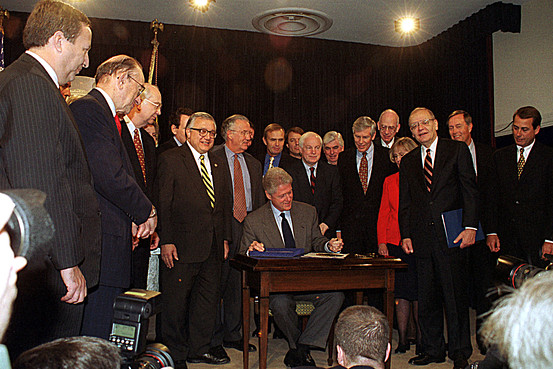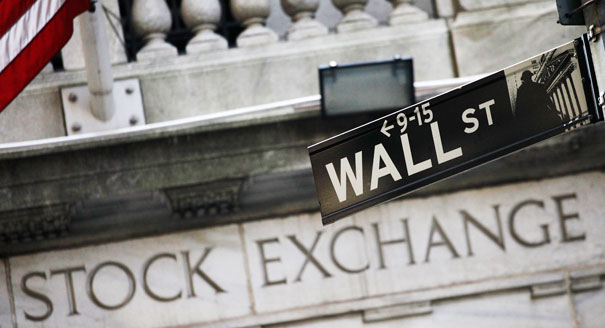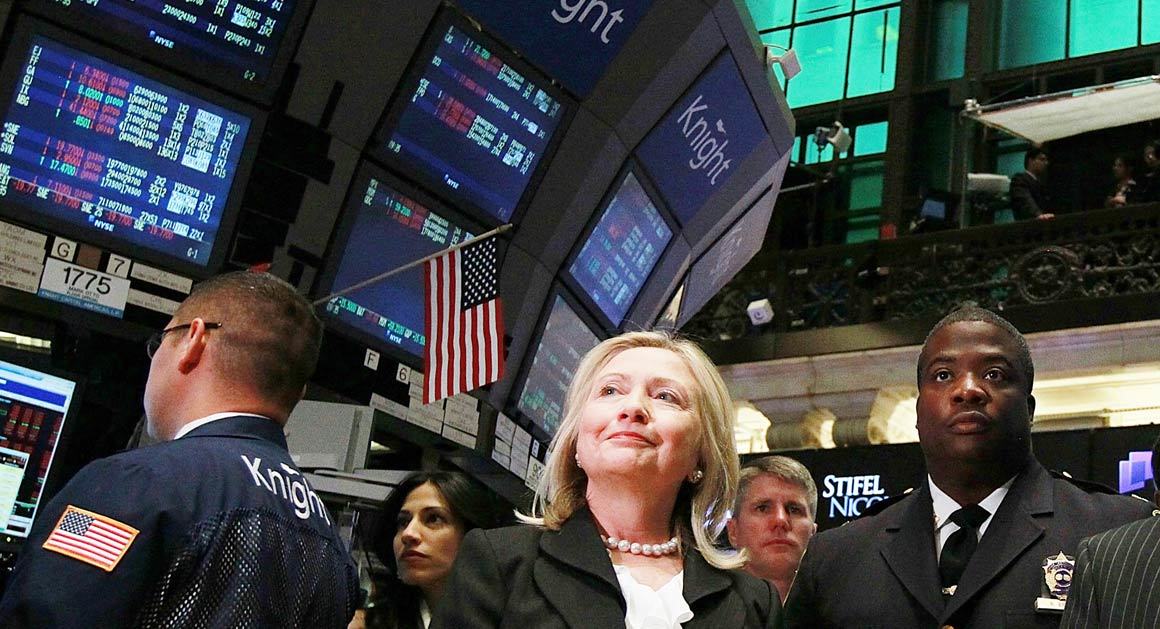By Joe Kearns
It is no secret that former U.S. Secretary of State Hillary Clinton, like her husband Bill, has Wall Street’s ear. She has built personal relationships with prominent banking executives like Goldman Sachs CEO Lloyd Blankfein, Morgan Stanley CEO James Gorman, JPMorgan Chase CEO Jamie Dimon, and Bank of America Merrill Lynch CEO Brian Moynihan. This outreach to Wall Street executives and their employees is particularly useful to Clinton in fundraising for the 2016 presidential campaign. “The money is already behind her,” a Wall Street money manager told Politico. “I don’t think it’s starting to line up behind her: It’s there for her if she wants it.”Like her establishment Republican counterparts, Clinton faces an opposition characterized by distrust of political elites. This opposition in the Democratic presidential primary has virtually been personified in the form of U.S. Senator Bernie Sanders, a democratic socialist from Vermont who once honeymooned in the Soviet Union and had a softball team called the “People’s Republic of Burlington.” It is safe to say Sanders has not endeared himself to the capitalist crowd backing Clinton.Sanders does not rival Clinton’s endorsements or fundraising in this campaign, but he has become a thorn in her side with surprising success in generating support in early primary states. Recent polls indicate that Sanders and Clinton have a virtual tie in both Iowa and New Hampshire. Clinton has a huge lead in the next primaries (South Carolina and Nevada), but it is worth watching if news from the early primaries produces a feedback loop which trims her advantage.A major reason for Sanders’s unlikely ascendance is the attractiveness of his anti-Wall Street populism to progressive voters in the Democratic Party. The concise diction (“Break up the banks”) of his proposals is catchy and easily understandable at a superficial level, in contrast to wonkiness of Clinton’s proposals. Financial markets, however, are complex and the question of which candidate’s regulatory policies have more social benefit requires a nuanced analysis.Glass-Steagall: Should It Be Resurrected? The Glass-Steagall Act was originally enacted in 1933 and it prohibited commercial banks from participating in the investment banking business. This was the case until the act was essentially repealed in 1999 under President Bill Clinton.Sanders has argued that the repeal of Glass-Steagall allowed investment banks to speculate with depositors’ money held in commercial banks, and, consequently, paved way for banks to merge with one another at a rapid pace to create institutions that were too big to fail. “Let’s not forget: President Franklin Roosevelt signed this bill into law precisely to prevent Wall Street speculators from causing another Great Depression,” Sanders said in a speech, according to boston.com. “And it worked for more than five decades, until Wall Street watered it down under President Reagan and killed it under President Clinton.”Clinton, like her husband, refutes the idea that Glass-Steagall triggered the financial crisis, pointing to the fact that the law would not have applied to any of the institutions at the heart of the crisis. New York Times columnist Andrew Ross Sorkin adds credence to Clinton’s argument by noting the irrelevance of Glass-Steagall to these institutions. For instance, Bear Stearns, Lehman Brothers, and Merrill Lynch were investment banks with no commercial banking business. For commercial banks like Bank of America and Wachovia, the problems stemmed from acquisitions of lenders Countrywide Financial and Golden West respectively. Other entities are not banks at all, and would not be regulated under Glass-Steagall: American International Group is an insurance company, while Fannie Mae and Freddie Mac are government-sponsored enterprises. When asked whether the financial crisis or JPMorgan Chase’s crisis-era $2 billion trading loss would have prevented by Glass-Steagall, U.S. Senator Elizabeth Warren (a leading proponent of restoring the act) conceded to Sorkin, “The answer is probably ‘No’ to both.”In fact, Bill Clinton argued that the rollback of Glass-Steagall made it easier for institutions to recover from the 2008 financial crisis, citing the acquisition of Merrill Lynch by Bank of America. In this context, it is difficult to prove that the rollback of Glass-Steagall has had adverse economic effects and there is some evidence was beneficial. There is a role for regulation of merged investment and commercial banks, but this should not inhibit the positive attributes of larger firms. While Glass-Steagall is an effective boogeyman for Sanders, it appears to be little more than that.Is Bigness Really Bad?
The Glass-Steagall Act was originally enacted in 1933 and it prohibited commercial banks from participating in the investment banking business. This was the case until the act was essentially repealed in 1999 under President Bill Clinton.Sanders has argued that the repeal of Glass-Steagall allowed investment banks to speculate with depositors’ money held in commercial banks, and, consequently, paved way for banks to merge with one another at a rapid pace to create institutions that were too big to fail. “Let’s not forget: President Franklin Roosevelt signed this bill into law precisely to prevent Wall Street speculators from causing another Great Depression,” Sanders said in a speech, according to boston.com. “And it worked for more than five decades, until Wall Street watered it down under President Reagan and killed it under President Clinton.”Clinton, like her husband, refutes the idea that Glass-Steagall triggered the financial crisis, pointing to the fact that the law would not have applied to any of the institutions at the heart of the crisis. New York Times columnist Andrew Ross Sorkin adds credence to Clinton’s argument by noting the irrelevance of Glass-Steagall to these institutions. For instance, Bear Stearns, Lehman Brothers, and Merrill Lynch were investment banks with no commercial banking business. For commercial banks like Bank of America and Wachovia, the problems stemmed from acquisitions of lenders Countrywide Financial and Golden West respectively. Other entities are not banks at all, and would not be regulated under Glass-Steagall: American International Group is an insurance company, while Fannie Mae and Freddie Mac are government-sponsored enterprises. When asked whether the financial crisis or JPMorgan Chase’s crisis-era $2 billion trading loss would have prevented by Glass-Steagall, U.S. Senator Elizabeth Warren (a leading proponent of restoring the act) conceded to Sorkin, “The answer is probably ‘No’ to both.”In fact, Bill Clinton argued that the rollback of Glass-Steagall made it easier for institutions to recover from the 2008 financial crisis, citing the acquisition of Merrill Lynch by Bank of America. In this context, it is difficult to prove that the rollback of Glass-Steagall has had adverse economic effects and there is some evidence was beneficial. There is a role for regulation of merged investment and commercial banks, but this should not inhibit the positive attributes of larger firms. While Glass-Steagall is an effective boogeyman for Sanders, it appears to be little more than that.Is Bigness Really Bad? Sanders’ campaign taps into an American political legacy of distrust in capitalistic institutions which consists of Andrew Jackson’s demonization of the Second Bank of the United States as the “monster bank,” William Jennings Bryan’s “Cross of Gold” speech, and Theodore Roosevelt’s trust-busting campaign. The prospect of undermining the power of elite institutions especially resonates with the public in the aftermath of the 2007-08 financial crisis.POLITICO senior staff writer Michael Grunwald complicates the uplifting populist narrative underlying Sanders’ financial reform proposals by arguing that the size of the largest U.S. financial institutions is not merely a necessary evil in a capitalist economy, but a positive good: “If JP Morgan hadn’t been big and strong enough to absorb the hemorrhaging balance sheets of Bear Stearns and Washington Mutual, we might well have endured a depression. Ditto if Wells Fargo hadn’t been big and strong enough to let Wachovia collapse in its arms. The world is also lucky Bank of America was big and (arguably) dumb enough to salvage Countrywide and Merrill Lynch from the jaws of death.”Sanders’ fear of institutions becoming “too-big-to-fail” is rational to an extent given the interdependence between banks, but he is wrong to believe simply reducing the size of banks eradicates risk. His solution in the “Too Big To Fail, Too Big To Exist Act” even exacerbates risk by creating enormous uncertainty in financial markets: “the Financial Stability Oversight Council shall compile and submit to the Secretary of the Treasury a list of entities that it deems Too Big To Fail, which shall include, but is not limited to, any United States bank holding companies that have been identified as systemically important banks by the Financial Stability Board…the Secretary of the Treasury shall break up entities included on the Too Big To Fail List, so that their failure would no longer cause a catastrophic effect on the United States or global economy without a taxpayer bailout.”The act lacks any definition or guidelines on what constitutes an institution that is “Too Big To Fail” or what procedure is to be used to break it up. Moreover, the risk-averse nature of investors suggests that the natural result of this act’s vagueness will be lower lending to all individuals including those who are low-income and, consequently, lower economic growth. In essence, Sanders’ solution is worse than the problem.What is Clintonian Capitalism?
Sanders’ campaign taps into an American political legacy of distrust in capitalistic institutions which consists of Andrew Jackson’s demonization of the Second Bank of the United States as the “monster bank,” William Jennings Bryan’s “Cross of Gold” speech, and Theodore Roosevelt’s trust-busting campaign. The prospect of undermining the power of elite institutions especially resonates with the public in the aftermath of the 2007-08 financial crisis.POLITICO senior staff writer Michael Grunwald complicates the uplifting populist narrative underlying Sanders’ financial reform proposals by arguing that the size of the largest U.S. financial institutions is not merely a necessary evil in a capitalist economy, but a positive good: “If JP Morgan hadn’t been big and strong enough to absorb the hemorrhaging balance sheets of Bear Stearns and Washington Mutual, we might well have endured a depression. Ditto if Wells Fargo hadn’t been big and strong enough to let Wachovia collapse in its arms. The world is also lucky Bank of America was big and (arguably) dumb enough to salvage Countrywide and Merrill Lynch from the jaws of death.”Sanders’ fear of institutions becoming “too-big-to-fail” is rational to an extent given the interdependence between banks, but he is wrong to believe simply reducing the size of banks eradicates risk. His solution in the “Too Big To Fail, Too Big To Exist Act” even exacerbates risk by creating enormous uncertainty in financial markets: “the Financial Stability Oversight Council shall compile and submit to the Secretary of the Treasury a list of entities that it deems Too Big To Fail, which shall include, but is not limited to, any United States bank holding companies that have been identified as systemically important banks by the Financial Stability Board…the Secretary of the Treasury shall break up entities included on the Too Big To Fail List, so that their failure would no longer cause a catastrophic effect on the United States or global economy without a taxpayer bailout.”The act lacks any definition or guidelines on what constitutes an institution that is “Too Big To Fail” or what procedure is to be used to break it up. Moreover, the risk-averse nature of investors suggests that the natural result of this act’s vagueness will be lower lending to all individuals including those who are low-income and, consequently, lower economic growth. In essence, Sanders’ solution is worse than the problem.What is Clintonian Capitalism?

Aware of the need to counter Sanders’ populist message, Clinton wrote an op-ed which awkwardly attempts to reconcile leftist sentiment with an array of piecemeal reforms which enhance, rather than undermine, free-market capitalism. In one vein, she copies Sanders’ message by arguing, “I would also ensure that the federal government has—and is prepared to use—the authority and tools necessary to reorganize, downsize and ultimately break up any financial institution that is too large and risky to be managed effectively.” Like Sanders, she does not clarify what kind of tools she would use to orchestrate such a breakup.On the other hand, there is a less ambitious, but more useful theme underlying Clinton’s reforms: to level the playing field and equalize information for financial markets. Her proposal to increase leverage and liquidity requirements for broker-dealers and impose strict margin requirements for short-term borrowing might be onerous, but, if comprehensibly constructed, it would equalize the oversight of the traditionally less-regulated shadow banking system and its more heavily-regulated commercial banking counterpart. This is laudable, as the financial crisis was partly a product of the disproportionately low regulation of hedge funds, investment banks, government-sponsored enterprises, and other non-banking financial institutions which make up the shadow banking system.Moreover, Clinton’s proposal to independently fund the Securities and Exchange Commission and Commodity Futures Trading Commission would provide more stability and consistency in the enforcement of financial regulations. Her suggestion of a tax on high-frequency trading not only fulfills this goal, but it reduces the ability of some investors to exploit others who lack their quality of information to make an optimal decision. The virtue of these reforms come from the positive externality of lower uncertainty for investors which leads to a bigger societal risk appetite sufficient for economic growth. Clinton’s proposal has flaws, namely its absence of adequate details regarding the size and scope of future regulation, but its promise lies in an understanding of the nuances of financial markets that Sanders lacks.The VerdictSanders suggests that the nature of capitalism is inherently flawed and requires a drastic upheaval of large financial institutions. Clinton’s reforms instead are largely designed to tweak the framework of financial markets to more optimally utilize the capabilities of capitalism. I have concluded that Clinton’s plan is more conducive to economic growth, a stronger risk appetite, and even the goal of reducing wealth inequality championed by Sanders. Yet, I credit Sanders for pushing financial reform to the forefront of this presidential election campaign and pressuring Clinton to respond to his ideas. Ironically, the democratic socialist senator has demonstrated the virtues of a competitive marketplace of ideas with his presence in the Democratic primary.Author's Note: As always, the content of this post solely reflects the views of the author, not the Penn State Economics Association.


